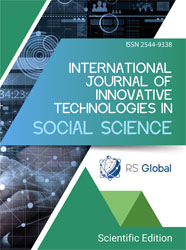THE IMPACT OF THE TRAMWAY ON PEDESTRIAN ACCESSIBILITY IN THE NEW CITY OF ALI MENDJELI IN CONSTANTINE
Abstract
The new city of Ali Mendjeli in Constantine has capitalized on the extension of the tramway line by adopting a sustainable mode of transportation that has significantly reduced car usage and alleviated congestion in the city. The introduction of the tramway has also led to the creation of outdoor amenities such as widened sidewalks, green spaces, and resting areas, which have promoted pedestrian activity. The objective of our research was to examine the impact of the tramway's arrival on pedestrian accessibility in this city. To achieve this, we employed a mixed methodology that combined quantitative and qualitative tools. We distributed a questionnaire to a sample of residents in the new city of Ali Mendjeli and conducted on-site observations as well. The findings of our study clearly demonstrated that the arrival of the tramway in the new city of Ali Mendjeli and the accompanying outdoor enhancements along its route have had a positive impact on pedestrian accessibility in the city.
References
Beier, R. (2020). The world-class city comes by tramway : Reframing Casablanca’s urban peripheries through public transport. Urban Studies, 57(9), 1827‑1844. https://doi.org/10.1177/0042098019853475
Boukelouha, R., & Gauthier, P. (2020.). Marchabilité en contextes urbains algériens traditionnel et contemporain: caractérisation de l’accessibilité piétonne à Constantine et Ali Mendjeli à l’aide de l’index walk scoretm. Rev. Roum. Géogr./Rom. Journ. Geogr., 64, (2), p. 199–213
Da Cunha, A., Knoepfel, P., & Leresche, J.-P. (2005). Enjeux du développement urbain durable : Transformations urbaines, gestion des ressources et gouvernance. Presses polytechniques et universitaires romandes.
De Vos, J., Lättman, K., Van Der Vlugt, A.-L., Welsch, J., & Otsuka, N. (2023). Determinants and effects of perceived walkability : A literature review, conceptual model and research agenda. Transport Reviews, 43(2), 303‑324. https://doi.org/10.1080/01441647.2022.2101072
Dovey, K., & Pafka, E. (2020). What is walkability? The urban DMA. Urban Studies, 57(1), 93‑108. https://doi.org/10.1177/0042098018819727
Ewing, R., & Handy, S. (2009). Measuring the Unmeasurable : Urban Design Qualities Related to Walkability. Journal of Urban Design, 14(1), 65‑84. https://doi.org/10.1080/13574800802451155
Frank, L. D., Sallis, J. F., Saelens, B. E., Leary, L., Cain, K., Conway, T. L., & Hess, P. M. (2010). The development of a walkability index : Application to the Neighborhood Quality of Life Study. British Journal of Sports Medicine, 44(13), 924‑933. https://doi.org/10.1136/bjsm.2009.058701
Glazier, R. H., Creatore, M. I., Weyman, J. T., Fazli, G., Matheson, F. I., Gozdyra, P., Moineddin, R., Shriqui, V. K., & Booth, G. L. (2014). Density, Destinations or Both? A Comparison of Measures of Walkability in Relation to Transportation Behaviors, Obesity and Diabetes in Toronto, Canada. PLoS ONE, 9(1), e85295. https://doi.org/10.1371/journal.pone.0085295
Horak, J., Kukuliac, P., Maresova, P., Orlikova, L., & Kolodziej, O. (2022). Spatial Pattern of the Walkability Index, Walk Score and Walk Score Modification for Elderly. ISPRS International Journal of Geo-Information, 11(5), 279. https://doi.org/10.3390/ijgi11050279
Koohsari, M. J., Sugiyama, T., Hanibuchi, T., Shibata, A., Ishii, K., Liao, Y., & Oka, K. (2018). Validity of Walk Score® as a measure of neighborhood walkability in Japan. Preventive Medicine Reports, 9, 114‑117. https://doi.org/10.1016/j.pmedr.2018.01.001
Le Gall, J., Roué-Le Gall, A., Potelon, J.-L., & Cuzin, Y. (2014). Agir pour un urbanisme favorable à la santé, concepts & outils. EHESP. https://www.ehesp.fr/wp-content/uploads/2014/09/guide-agir-urbanisme-sante-2014-v2-opt.pdf
Lo, R. H. (2009). Walkability : What is it? Journal of Urbanism: International Research on Placemaking and Urban Sustainability, 2(2), 145‑166. https://doi.org/10.1080/17549170903092867
Manaugh, K., & El-Geneidy, A. (2011). Validating walkability indices : How do different households respond to the walkability of their neighborhood? Transportation Research Part D: Transport and Environment, 16(4), 309‑315. https://doi.org/10.1016/j.trd.2011.01.009
Maupu, J.-L., & Wiel, M. A. de la postface. (2006). La ville creuse pour un urbanisme durable : Nouvel agencement des circulations et des lieux.Ed. L'Harmattan
Moayedi, F., Zakaria, R., Bigah, Y., Mustafar, M., Che Puan, O., Zin, I. S., & Klufallah, M. M. A. (2013). Conceptualising the Indicators of Walkability for Sustainable Transportation. Jurnal Teknologi, 65(3). https://doi.org/10.11113/jt.v65.2151
Ouzir, M. (2022). Assessment of walkability in the city centre of M’sila using a qualitative barometer. Glasnik Srpskog Geografskog Drustva, 102(2), 173‑184. https://doi.org/10.2298/GSGD2202173O
Pivo, G., & Fisher, J. D. (2011). The Walkability Premium in Commercial Real Estate Investments : The Walkability Premium in Commercial Real Estate Investments. Real Estate Economics, 39(2), 185‑219. https://doi.org/10.1111/j.1540-6229.2010.00296.x
Raulin, F., Lord, S., & Negron-Poblete, P. (2016). Évaluation de la marchabilité de trois environnements urbains de la région métropolitaine montréalaise à partir de l’outil MAPPA. VertigO, Volume 16 numéro 2. https://doi.org/10.4000/vertigo.17774
Shamsuddin, S., Hassan, N. R. A., & Bilyamin, S. F. I. (2012). Walkable Environment in Increasing the Liveability of a City. Procedia - Social and Behavioral Sciences, 50, 167‑178. https://doi.org/10.1016/j.sbspro.2012.08.025
Stambouli, J. (2005). Les territoires du tramway moderne : De la ligne à la ville durable. Développement durable et territoires, Dossier 4. https://doi.org/10.4000/developpementdurable.3579
Su, S., Zhou, H., Xu, M., Ru, H., Wang, W., & Weng, M. (2019). Auditing street walkability and associated social inequalities for planning implications. Journal of Transport Geography, 74, 62‑76. https://doi.org/10.1016/j.jtrangeo.2018.11.003
Van Dyck, D., Deforche, B., Cardon, G., & De Bourdeaudhuij, I. (2009). Neighbourhood walkability and its particular importance for adults with a preference for passive transport. Health & Place, 15(2), 496‑504. https://doi.org/10.1016/j.healthplace.2008.08.010
Wang, H., & Yang, Y. (2019). Neighbourhood walkability : A review and bibliometric analysis. Cities, 93, 43‑61. https://doi.org/10.1016/j.cities.2019.04.015
Views:
584
Downloads:
1732
Copyright (c) 2023 Mehdi Kaghouche, Imane Benkechkache

This work is licensed under a Creative Commons Attribution 4.0 International License.
All articles are published in open-access and licensed under a Creative Commons Attribution 4.0 International License (CC BY 4.0). Hence, authors retain copyright to the content of the articles.
CC BY 4.0 License allows content to be copied, adapted, displayed, distributed, re-published or otherwise re-used for any purpose including for adaptation and commercial use provided the content is attributed.











